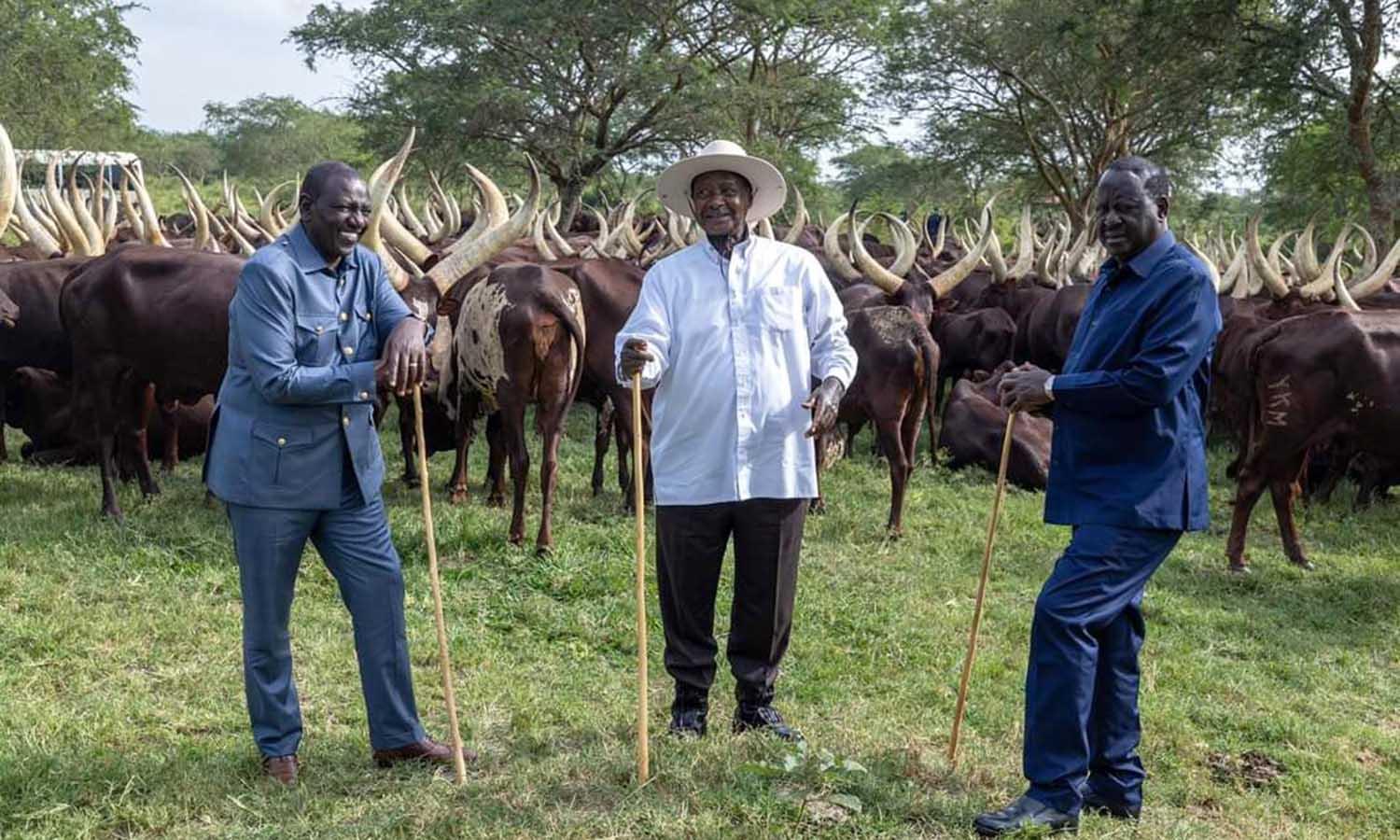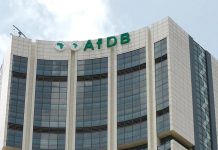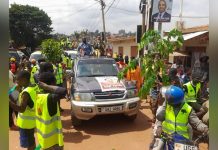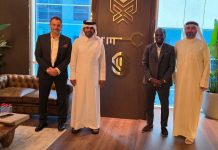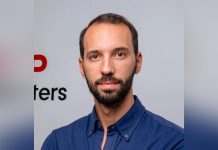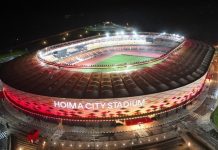Africa-Press – Uganda. At the inauguration of Dr William Samoei Ruto as Kenya’s fifth president on September 13, 2022, at the Kasarani stadium in Nairobi, President Museveni arrived at the venue shortly after outgoing president Uhuru Kenyatta and Mr Ruto had separately inspected the parade, and all guests were seated.
Dressed in a grey suit, yellow neck-tie and white shirt, Mr Museveni emerged from the back of the VIP pavilion carrying his trademark hat, and went to his reserved seat at the front amid ululation from the filled-to-the-rafters stadium. And shortly after, while inviting Mr Museveni to speak on behalf of the visiting heads of State, Dr Ruto referred to the Ugandan president, now 79, as the grandfather of the region.
In Mr Museveni’s speech, he stressed the need for regional political integration while safeguarding trade by removing artificial barriers to business.
Yet in just one year after Dr Ruto taking charge of the region’s economic powerhouse, relations between Nairobi and Kampala dipped, with trade and petroleum being at the heart of the matter. The other issues have been Kenya blocking dairy and poultry products from Uganda and other agricultural produce, something that has reversed gains made by the two countries as the leading trading partners in the region.
The two governments have been sending emissaries to either capitals in the recent months in a bid to sort out the mess.
This Monday’s meeting may warm cooling relations, but the mixed signals it sent to the Kenyan and Ugandan political arenas were hot and cold in equal measure.
The pictures of Dr Ruto and Opposition stalwart Raila Odinga having a tête-à-tête with President Museveni at Uganda’s leader’s farm in Kisozi, Gomba District, sent tongues wagging in the two countries.
The meeting, held far from the madding crowd, caught many off-guard – and the speculative rumour mill went into overdrive, especially on social media. And rightly so.
What was on the cards? In Greek philosopher Plato’s Republic, a government exists for the benefit of all citizens and all social classes, and must mediate between potentially conflicting interests.
But on the pure political chessboard, the electorate faces a conundrum of understanding politicians’ interests and if they really represent ‘us’. And in the political economy of it, the affluent 10 percent will decide what the 90 percent of the rest follow and believe. Dr Ruto and Mr Odinga sway millions of voters and the principals’ actions and inactions influence their moods in any direction.
However, before we delve into the political undertones and overtones of the meetings, it is imperative to first understand how we ended up with the said pictures.
The meeting
The three-hour meetings, which began shortly after midday, were a culmination of several overt and covert arrangements made possible through frantic shuttle diplomacy within the region and beyond.
Ambassador Joseph Ocwet, Uganda’s director general of the External Security Organisation, was instrumental in the Kisozi meetings, this media house established.
When we reached out to him, he said the meetings between Dr Ruto, Mr Odinga and Mr Museveni were arranged because Raila’s camp had contacted him to arrange a meeting with the Ugandan leader. Mr Museveni agreed to meet at the weekend.
Coincidentally, Dr Ruto was scheduled to travel for a separate meeting with his Ugandan counterpart.
On Sunday, Mr Odinga flew into Entebbe International Airport from Windhoek, Namibia, where he had attended the funeral service of Hage Geingob, who died in office as president of that country.
Geingob died on February 4, weeks after being diagnosed with cancer, and was buried at Heroes Acre on Sunday.
Mr Odinga was in Kampala to seek Mr Museveni’s hand in his quest for the African Union Commission leadership with the help of Amb Ocwet. It is believed in Mr Odinga’s circles that Mr Museveni holds sway over many regional leaders and his ability to play the long ball would boost his bid.
“I am the one who coordinated both teams and ensured the meetings happened. I only attended the meeting that discussed the EAC federation and Mr Odinga’s AU chairmanship bid,” Amb Ocwet said yesterday.
When Mr Odinga arrived in Kampala, Amb Ocwet informed him that President Ruto was en route to Uganda the following day for a planned meeting with Mr Museveni on energy and petroleum, so it would be useful to have the meeting rescheduled to the next day.
Both Mr Museveni and Mr Odinga are said to have okayed the idea. So Odinga and his entourage that included Prof Makau Mutua, Junet Muhammed and a host of other Kenyan politicians spent the night in Kampala.
At about midday on Monday, Mr Ruto jetted into the country in the company of his Energy Cabinet Secretary Davis Chirchir and a group of technocrats.
Amb Ocwet was at their service at Entebbe. He secured a military helicopter for Mr Odinga and team, who flew to Kisozi, and then President Ruto and team would use President Museveni’s helicopter; arriving at the farm just a few minutes after the Raila team.
“The agenda had two items; the East African Community political federation and the energy and petroleum impasse between the two countries.
But because Odinga was here and we had agreed to host him at Kisozi, we included the African Union chairmanship to make it the third item on the agenda,” Amb Ocwet revealed.
Kenya and Uganda reportedly agreed to fast-track the political federation quest, first by moving with the willing, and rallying other regional heads to come on board along the way.
People familiar with the meeting said when Dr Ruto and Mr Museveni concluded the two items on the agenda, Mr Odinga and team were then ushered into the tent where his prospective candidacy for the AU role was discussed in detail.
Mr Museveni and Dr Ruto gave him the nod after discussing his chances at the election, and what his role would mean for the region at large. It is upon this that the two heads of State promised to rally regional and African leaders to support the bid.
It was agreed that the Ministry of Foreign Affairs, which was not represented in the meeting, would take over Uganda’s campaigns for the Odinga candidature and also fast-track the regional integration process.
In order to reverse the damage done by the fight over petroleum, the two heads of State agreed that their ministries would be key in driving the agenda and a resolution would soon be reached.
Both Dr Ruto and Mr Odinga returned to Nairobi on Monday evening.
Multiple sources this newspaper spoke to said those expected at the meeting were Energy and Mineral Development minister Ruth Nankabirwa, her PS Pauline Irene Batebe, and the Uganda National Oil Company (Unoc) Chief Executive Officer Proscovia Nabbanja, among others.
Ms Nankabirwa, however, said she and the team did not attend the meeting because it was an affair of heads of State.
“I returned from Tanzania on Sunday where I had been sent [by President Museveni] to meet President Samia Suluhu because we are trying to get a safer route for our oil but we are having some logistical issues which we are trying to sort out,” she said, and promised to give more details on the trip.
Last week, this newspaper reported that Uganda and Tanzania were planning to jointly construct a pipeline to carry Uganda’s petroleum products from Tanga Port in Tanzania to Kampala. Tanzania has come into the picture after Kenya turned the tables on Uganda because of its decision to write a law granting a monopoly over fuel importation to the Uganda National Oil Company – a decision which shuts out Kenyan middlemen who have been making a killing selling fuel to Uganda.
The politics
While the issue of trade and EAC federation may have been key on the agenda, the third item stole the show among Ugandans and Kenyans. And for many reasons.
The AU Commission chairperson seat is set to become vacant next year after the incumbent, Moussa Faki, who hails from Chad, ends his four-year term.
The chairperson serves as the chief executive officer and legal representative of the AU, overseeing administrative and financial matters.
In 2017, Kenya’s Amina Mohamed lost to Mr Faki and Kenya’s renewed stab at the seat is seen as a quest for what they missed.
Last Thursday, Mr Odinga announced that he had thrown his hat into the ring for the AU leadership, arguably one of Africa’s most prestigious political positions.
“If the leadership of Africa desires my services, I am prepared and offer myself to serve this continent. I am ready to pursue the chairmanship of the African Union,” Mr Odinga said.
The announcement, and the meeting in the ranch, given Mr Odinga’s footprints in Kenyan politics for decades, carried loads of ramifications.
The chairperson of the African Union Commission is elected to a four-year term, renewable once. This means Mr Odinga would be chairman of the AU by the time the next Kenyan election comes around the corner in 2027.
A highly placed source in Nairobi told this publication yesterday that members of former Kenyan leader, Uhuru Kenyatta’s camp, were interested in Mr Odinga remaining in the Kenyan political space as part of Azimio la Umoja’s bid to stage a comeback in the political arena after the 2022 shock defeat to Dr Ruto.
This is why an impression has been created that Mr Kenyatta was in favour of former Tanzanian president Jakaya Kikwete taking the AU chairmanship ahead of his preferred presidential candidate in the last election.
But in the other corner, members of Kenya’s ruling political coalition, Kenya Kwanza, have been upbeat about the prospects of sending Mr Odinga to Addis Ababa, with many viewing it as a way to clear the ground for Dr Ruto to easily build a war chest and machinery ahead of the 2027 General Election.
While from accounts the Kisozi meeting may have been ‘coincidental’, some think it was a planned coincidence because of the players involved. It was viewed as a consultative meeting with the region’s ‘grandfather’ as Dr Ruto once said.
A student of former Kenyan president, the late Daniel arap Moi, and a blue-eyed boy during the high noon of Moi’s perceived plutocracy, Dr Ruto is famed for his political game, having also worked closely with Mr Odinga and Mr Kenyatta on his way to the presidency. His ability to wrest the Rift Valley from the Mois, and also snatch Mt Kenya from the Kenyattas have been some of the examples of his political mettle.
Equally so, the ability to remain relevant in the political space for close to four decades, keeping successive governments on their toes, and maintaining a firm grip on his lieutenants over the years, has endeared Mr Odinga to friends and foe alike.
The game to the AU leadership has thus left public opinion divided on whether Mr Odinga is finally giving up on local politics at the urging of Dr Ruto, or is re-engineering his career to remain relevant in 2027.
The meeting came on the day political analysts and naysayers alike had started floating names of possible successors of the Odinga political machine in Nyanza politics. Among them were John Mbadi, Opiyo Wandayi, Anyang’ Nyong’o, James Orengo, Evans Kidero, and Okoth Obado.
But a Daily Nation story the same day on ‘the return of Raila’, indicating his trademark anti-government stances poured cold water on the stories.
A story for the ages waits us when the voting comes around the corner, whether Mr Odinga makes it or not.
Uganda-Kenya fuel impasse
The move to look south for an alternative fuel importation route was triggered by an uncertain posture by the Nairobi regime on Uganda’s petroleum trade.
Ms Nankabirwa, on January 22, told journalists that her ministry had embarked on discussions with Tanzania following Kenya’s continuous frustration of Uganda’s planned sole fuel importation takeover by the Uganda National Oil Company (Unoc).
“We know that the alternative route might be expensive because of the logistics that are involved, but we also know there is a possibility of negotiation with the Government of Tanzania to waive some taxes,” she added.
Under the new importation plan, the government empowered its state-owned Unoc to take over sole importation of petroleum products into the country and later sell to the more than 40 local oil-marketing companies.
Uganda plans to change its current fuel importation system from Open Tender System (OTS) to Government-to-Government (GtG) importation method.
Government under the GtG system empowered Unoc to import all petroleum products and later sell to local Oil Marketing Companies (OMCs) unlike the OTS where Uganda OMCs would buy from their Kenyan counterparts directly.
Uganda’s Parliament enacted the Petroleum Supply Amendment Act, 2023, in October and was signed into law by President Museveni in November last year. This was set to activate the Unoc plan in January before Kenya frustrated it.
Through the arrangement, Unoc was supposed to use the Kenyan Pipeline to transport her petroleum products to Kisumu where Ugandan trucks would pick them up, a decision the Nairobi authorities have frustrated.
The Kenyan state-owned Energy and Petroleum Regulatory Authority (Epra) denied Unoc the import licence before the two countries engaged in diplomacy, prompting the Kenyan Energy Cabinet Secretary to direct Epra to waive the requirements they had placed on Unoc. But before this could be done, some private Kenyan citizens ran to court and blocked the whole exercise.
Uganda filed an application requesting the High Court in Machakos to dismiss the case where Royani Energy Ltd, John Kinuthia Mwangi, and Acacia Ridge Construction, successfully on November 7, secured an order from the same court blocking Epra from issuing an import licence to Unoc.
Unoc’s application was first heard on December 6, 2023, and then pushed to December 19, then again to January 22, where the same court extended its judgement to February 12.
Ms Nankabirwa said her ministry could not just sit by and wait on the courts, but would rather seek alternative routes to avert any likely crisis.
“Tanzania is a secure route and if Kenya opens up and gives us the certificate, we will move with them, and divide the volume between both countries,” she said.
Ruto-Raila love-hate relationship
For many, the Kisozi picture evoked memories of close to 20 years ago when Mr Odinga and Dr Ruto worked together to form the all-politically powerful Pentagon domiciled in Chungwa House that led an electrifying campaign, with Ruto delivering the whole Rift Valley en masse to Orange Democratic Movement (ODM) despite warnings from his mentor and political father Daniel arap Moi.
The Pentagon politburo included politicians such as Musalia Mudavadi, Najib Balala and Joseph Njaga (RIP).
While the ODM did not clinch the presidency after a hotly contested election, they were given half of the government following the death of hundreds and displacement of 600,000 people in the ensuing post-election violence. Mwai Kibaki (RIP) was controversially declared the winner of the presidential election held on December 27, 2007.
The two principals would part ways after forming government and remained rivals until the last election.
Dr Ruto would go on to serve as deputy president for two terms, having supported Mr Kenyatta’s presidential bid in 2013. When he fell out with his boss, Mr Kenyatta, in the second term, Ruto ran away with Raila’s political playbook and rallied the electorate on the hustler narrative, taking the presidency by a close margin.
In the aftermath of the poll, Mr Odinga led anti-government protests that saw destruction of property and loss of life. It is seen that the current relationship is meant to tame Mr Odinga.
Raila, Ruto legs in Ugandan politics
Ahead of the 2016 General Election in Uganda, Dr Ruto led a team of Kenyan politicians that actively campaigned for President Museveni in Sebei, an area inhabited by Kalenjin, a community that Dr Ruto belongs to. His subsequent frequent visit to Uganda was widely seen as a cordial relationship with Kampala. At the last election in Kenya, some believed he had the un-mentioned support of the NRM government.
On the other hand, Mr Odinga, and Mr Museveni had frosty relations after the 2007 election when supporters of Odinga suspected Uganda’s disinclination against Odinga and ripped of sections of the railway line in Nairobi. In 2010, Odinga appeared in Museveni’s campaign rallies. In March 2012, he visited Museveni at Entebbe, two weeks after Museveni was in Kisumu in what was seen as mending relations.
What the leaders said…
President Museveni.
I was happy to meet President Ruto and Rt Hon Odinga this afternoon at my farm in Kisozi. We discussed issues of mutual interest between our two countries and the East African Community. I welcome them.”
Kenya President William Ruto.
Had the pleasure of meeting President @KagutaMuseveni at his Kisozi country home in Uganda. We discussed critical issues that affect our two countries such as energy and petroleum. Kenya and Uganda are committed to the deepening of the long-established diplomatic and economic ties between our two countries. This relationship includes bringing all the seven East African Community nations closer in their ultimate goal to form the East African political federation. Also discussed was the declared candidacy of Kenya’s former Prime Minister @RailaOdinga for the Africa Union Commission chairmanship. I am glad that the issues affecting the flow of petroleum products between Kenya and Uganda are being resolved. We have agreed on a way forward of sourcing and scheduling imports for the region in a manner that will ensure we achieve the most competitive pricing and maximum logistical efficiency. In my meeting with President @KagutaMuseveni today, we also discussed the need for the two countries to urgently pursue the
design and construction of the earlier conceptualised Eldoret-Kampala-Kigali refined petroleum product pipeline.”
Raila Odinga.
Several days ago, I accepted an invitation from President Museveni of Uganda for a joint meeting with President William Ruto today to discuss the deepening of regional integration within the East African Community. Crucially, at the urging of President Museveni, we also discussed my candidacy for Chairperson of the African Union Commission. I am very grateful to President Museveni for strongly endorsing my candidacy and to President Ruto for fully backing it.”
For More News And Analysis About Uganda Follow Africa-Press

